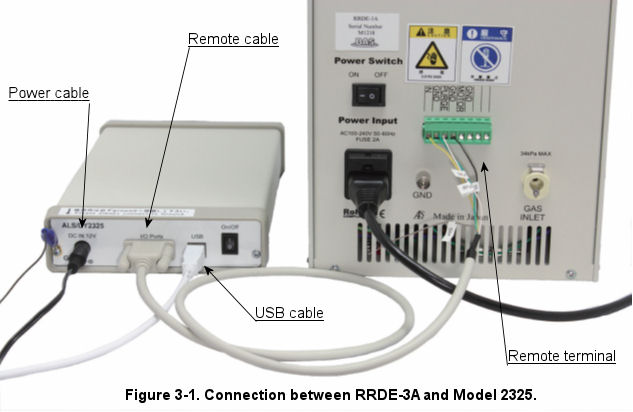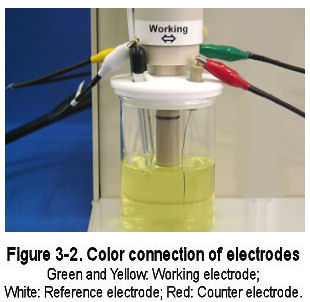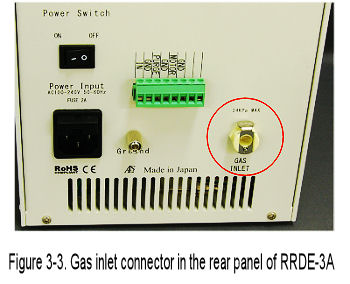3. Connection of RRDE-3A and Potentiostat

- RRDE-3A control:
In case of RRDE-3A works with CHI or BASi apparatus, a banana plug cable is connected with the RDE and GND, and the alternative cable is connected with the terminal connector and GND of the RRDE-3A.
One volt corresponds to 1,000 rpm, and it is possible to control 90 to 8,000 rpm from 0 to 8 DC volts. The rotation speed from the 90 to 8,000 rpm can be controlled in order to the specification of the RRDE-3A rotator.
The purge and pintch valve into RRDE-3A is controlled by TTL level Active Low. The signal from MOTOR/GND stops the motor on the REMOTE or LOCAL mode.
- RRDE-3A to Non-ALS Instruments:
The RRDE-3A should work, at least in the manual mode, with virtually any instrument. The CELL cable is attaching the appropriate connector for the particular instrument.
- Electrode leads:

The reference and counter electrodes lead wires extend from the potentiostats. The connectors are the press-on type. Simply push the connector over the corresponding pin in the electrode to make the connection (Fig. 3-2). Aligator clips are color coded to the electrode which it attaches.
- Gas inlet connection:

The RRDE-3A includes 0.25" O.D. tygon tube and a gas line fitting. One end of the fitting connects to the ‘GAS INLET’ port on the rear panel of the RRDE-3A. To attach the line, simply push the connector (See Fig. 3-3).
The open end of the tygon tube is connected to a regulated gas supply. The inlet gas pressure must not exceed 5 psi.
To remove the tube from RRDE-3A, squeeze the retaining ring tab against the connector and then pull the tube and connector away from the RRDE-3A.
- Cell and electrodes setting:
RRDE-3A is designed for easy cell replacement and to accommodate regular cells. The cell is held in place by stainless steel plate.
These instructions should be followed for initial cell setting:
| 1) A glass cell vial is placed on the silicon plate. | |
| 2) A Teflon cap is put on the glass cell. | |
| 3) Reference electrode, counter electrode and purge tubings are fized at the cell holder. | |
| &refx(): File not found: "Figure_3-4_4.JPG" at dir "xdata/rrde-3a_n/"; | 4) Five holes are situated in the Teflon cap. These holes are for the reference electrode, counter electrode, working electrode, and purge tubings. Place the electrodes in the most convenient position. |
| 5) Reference and counter electrodes are put into Teflon cap to adjust the desired position by O-Ring. - Counter electrode - Red aligator clip - Reference electrode - White aligator clip |
- Purge line connection:
The RRDE-3A has the ability to purge the sample solution with an inert gas. The purge removes oxygen by bubbling with an inert gas, typically Nitrogen or Helium through the solution.
The purge line consists of a teflon tube emmerging from the teflon cap.
This line should be set up to the down side of the cell holder. The depth of the purge tube should be near the bottom of the cell vial.
In order to access the purge tube when RRDE-3A is lowered, you should prepare for adjusted length of the tube.

